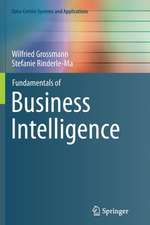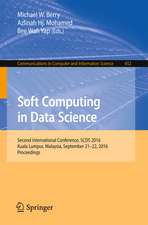Applied Data Science: Lessons Learned for the Data-Driven Business
Editat de Martin Braschler, Thilo Stadelmann, Kurt Stockingeren Limba Engleză Hardback – 25 iun 2019
With these goals in mind, the book is divided into three parts: Part I pays tribute to the interdisciplinary nature of data science and provides a common understanding of data science terminology for readers with different backgrounds. These six chapters are geared towards drawing a consistent picture of data science and were predominantly written by the editors themselves. Part II then broadens the spectrum by presenting views and insights from diverse authors – some from academia and some from industry, ranging from financial to health and from manufacturing to e-commerce. Each of these chapters describes a fundamental principle, method or tool in data science by analyzing specific use cases and drawing concrete conclusions from them. The case studies presented, and the methods and tools applied, represent the nuts and bolts of data science. Finally, Part III was again written from the perspective of the editors and summarizes the lessons learned that have been distilled from the case studies in Part II. The section can be viewed as a meta-study on data science across a broad range of domains, viewpoints and fields. Moreover, it provides answers to the question of what the mission-critical factors for success in different data science undertakings are.
The book targets professionals as well as students of data science:first, practicing data scientists in industry and academia who want to broaden their scope and expand their knowledge by drawing on the authors’ combined experience. Second, decision makers in businesses who face the challenge of creating or implementing a data-driven strategy and who want to learn from success stories spanning a range of industries. Third, students of data science who want to understand both the theoretical and practical aspects of data science, vetted by real-world case studies at the intersection of academia and industry.
Preț: 1059.44 lei
Preț vechi: 1324.30 lei
-20% Nou
Puncte Express: 1589
Preț estimativ în valută:
202.73€ • 216.78$ • 169.03£
202.73€ • 216.78$ • 169.03£
Carte tipărită la comandă
Livrare economică 17 aprilie-01 mai
Preluare comenzi: 021 569.72.76
Specificații
ISBN-13: 9783030118204
ISBN-10: 3030118207
Pagini: 230
Ilustrații: XIII, 465 p. 121 illus., 92 illus. in color.
Dimensiuni: 155 x 235 mm
Greutate: 0.84 kg
Ediția:1st ed. 2019
Editura: Springer International Publishing
Colecția Springer
Locul publicării:Cham, Switzerland
ISBN-10: 3030118207
Pagini: 230
Ilustrații: XIII, 465 p. 121 illus., 92 illus. in color.
Dimensiuni: 155 x 235 mm
Greutate: 0.84 kg
Ediția:1st ed. 2019
Editura: Springer International Publishing
Colecția Springer
Locul publicării:Cham, Switzerland
Cuprins
Preface.- 1 Introduction.- 2 Data Science.- 3 Data Scientists.- 4 Data products.- 5 Legal Aspects of Applied Data Science.- 6 Risks and Side Effects of Data Science and Data Technology.- 7 Organization.- 8 What is Data Science?.- 9 On Developing Data Science.- 10 The ethics of Big Data applications in the consumer sector.- 11 Statistical Modelling.- 12 Beyond ImageNet - Deep Learning in Industrial Practice.- 13 THE BEAUTY OF SMALL DATA - AN INFORMATION RETRIEVAL PERSPECTIVE.- 14 Narrative Visualization of Open Data.- 15 Security of Data Science and Data Science for Security.- 16 Online Anomaly Detection over Big Data Streams.- 17 Unsupervised Learning and Simulation for Complexity Management in Business Operations.- 18 Data Warehousing and Exploratory Analysis for Market Monitoring.- 19 Mining Person-Centric Datasets for Insight, Prediction, and Public Health Planning.- 20 Economic Measures of Forecast Accuracy for Demand Planning - A Case-Based Discussion.- 21 Large-Scale Data-DrivenFinancial Risk Assessment.- 22 Governance and IT Architecture.- 23 Image Analysis at Scale for Finding the Links between Structure and Biology.- 24 Lessons Learned from Challenging Data Science Case Studies.
Recenzii
Notă biografică
Prof. Dr. Martin Braschler is a senior lecturer at the Zurich University of Applied Sciences (ZHAW), as well as head of the Information Engineering group that is located at the Institute of Applied Information Technology. His main research interests are in the field of unstructured information, specifically information retrieval evaluation, cross-language information retrieval, and natural language processing. He was one of the original initiators of the CLEF campaigns, which are the largest European forum for benchmarking of systems from the area of information retrieval and related fields. Prior to joining ZHAW, he served as head of research and innovation at Eurospider Information Technology AG, Zurich, Switzerland, a vendor of information retrieval solutions, and has thus extensive experience in the transfer of state-of-the-art technology to the commercial marketplace.
Prof. Dr. Thilo Stadelmann is a senior lecturer in computer science at ZHAW School of Engineering in Winterthur. His current research focuses on applications of machine learning, especially deep learning, to diverse kinds of data. He is head of the ZHAW Data Science Laboratory and member of the board of the Swiss Alliance for Data-Intensive Services. Before joining ZHAW, Thilo headed a team of software developers and data miners at TWT GmbH Science & Innovation, developing tailor-made data management applications for the German automotive industry. He has more than 10 years of experience as a professional software developer.
Textul de pe ultima copertă
This book has two main goals: to define data science through the work of data scientists and their results, namely data products, while simultaneously providing the reader with relevant lessons learned from applied data science projects at the intersection of academia and industry. As such, it is not a replacement for a classical textbook (i.e., it does not elaborate on fundamentals of methods and principles described elsewhere), but systematically highlights the connection between theory, on the one hand, and its application in specific use cases, on the other.
With these goals in mind, the book is divided into three parts: Part I pays tribute to the interdisciplinary nature of data science and provides a common understanding of data science terminology for readers with different backgrounds. These six chapters are geared towards drawing a consistent picture of data science and were predominantly written by the editorsthemselves. Part II then broadens the spectrum by presenting views and insights from diverse authors – some from academia and some from industry, ranging from financial to health and from manufacturing to e-commerce. Each of these chapters describes a fundamental principle, method or tool in data science by analyzing specific use cases and drawing concrete conclusions from them. The case studies presented, and the methods and tools applied, represent the nuts and bolts of data science. Finally, Part III was again written from the perspective of the editors and summarizes the lessons learned that have been distilled from the case studies in Part II. The section can be viewed as a meta-study on data science across a broad range of domains, viewpoints and fields. Moreover, it provides answers to the question of what the mission-critical factors for success in different data science undertakings are.
The book targets professionals as well as students of data science: first, practicing data scientists in industry and academia who want to broaden their scope and expand their knowledge by drawing on the authors’ combined experience. Second, decision makers in businesses who face the challenge of creating or implementing a data-driven strategy and who want to learn from success stories spanning a range of industries. Third, students of data science who want to understand both the theoretical and practical aspects of data science, vetted by real-world case studies at the intersection of academia and industry.
With these goals in mind, the book is divided into three parts: Part I pays tribute to the interdisciplinary nature of data science and provides a common understanding of data science terminology for readers with different backgrounds. These six chapters are geared towards drawing a consistent picture of data science and were predominantly written by the editorsthemselves. Part II then broadens the spectrum by presenting views and insights from diverse authors – some from academia and some from industry, ranging from financial to health and from manufacturing to e-commerce. Each of these chapters describes a fundamental principle, method or tool in data science by analyzing specific use cases and drawing concrete conclusions from them. The case studies presented, and the methods and tools applied, represent the nuts and bolts of data science. Finally, Part III was again written from the perspective of the editors and summarizes the lessons learned that have been distilled from the case studies in Part II. The section can be viewed as a meta-study on data science across a broad range of domains, viewpoints and fields. Moreover, it provides answers to the question of what the mission-critical factors for success in different data science undertakings are.
The book targets professionals as well as students of data science: first, practicing data scientists in industry and academia who want to broaden their scope and expand their knowledge by drawing on the authors’ combined experience. Second, decision makers in businesses who face the challenge of creating or implementing a data-driven strategy and who want to learn from success stories spanning a range of industries. Third, students of data science who want to understand both the theoretical and practical aspects of data science, vetted by real-world case studies at the intersection of academia and industry.
Caracteristici
Systematically highlights the connection between theory, on the one end, and its application in specific use cases, on the other Each chapter describes a fundamental principle, method or tool in data science by analyzing specific use cases and drawing concrete conclusions from them Provides answers to the question of what the mission-critical factors for success in data science projects are

























